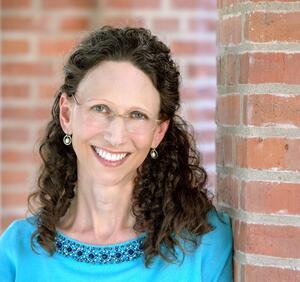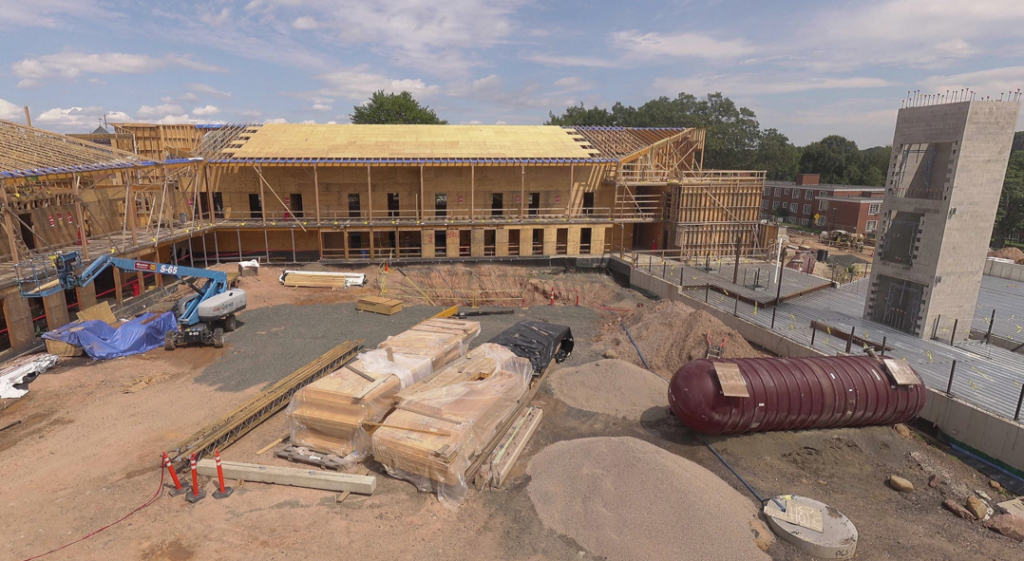By Kim Lawton
Willie James Jennings often tells his students that “if you don’t value water, then you can’t say you value life.” Jennings, Andrew W. Mellon Professor of Systematic Theology and Africana Studies, believes that life and water are morally and spiritually bound together. He says the Living Village project currently under construction on the YDS campus embodies that concept: “It shows to the world that the way we work with water, treat water, produce, sustain, and pass along the gift of water, says everything about how we value life.”
 The Divinity School’s Living Village is designed to be the largest living-building housing complex on a university campus. The regenerative Village will house approximately 50 students in units ranging from single “monastic-style” rooms to small two-bedroom apartments, with individually plumbed bathrooms. One-bedroom and two-bedroom units will have their own kitchens, and the residence hall will also have community and small-group kitchens, community dining rooms, and laundry facilities.
The Divinity School’s Living Village is designed to be the largest living-building housing complex on a university campus. The regenerative Village will house approximately 50 students in units ranging from single “monastic-style” rooms to small two-bedroom apartments, with individually plumbed bathrooms. One-bedroom and two-bedroom units will have their own kitchens, and the residence hall will also have community and small-group kitchens, community dining rooms, and laundry facilities.
Scheduled to be occupied beginning in August 2025, the Living Village is designed to meet the rigorous standards of the Living Building Challenge (LBC), an international certification system for sustainable design and construction. The goal of the challenge is to go beyond net-zero carbon designs to create buildings that generate more energy than they use, and to enhance, rather than burden, their areas’ water infrastructure. To accomplish this, the LBC has developed a framework for buildings that behave “like a flower,” as the LBC puts it, and “give more than they take.” One of seven designated performance categories, or “petals,” is water.
The Living Village’s hydrologic cycle has been the project’s most complex challenge. “The design has several innovative approaches to promote responsible water use, minimize water waste through collection, storage, and reuse, and avoid downstream impacts and pollution,” says Living Village Project Manager Bruce McCann. Potable water will come from the nearby municipal Whitney Water Purification Facility and Park, which is certified as a LEED Platinum facility, the highest level in the LEED green building certification system (one step below the LBC certification level).
The Living Village building will also capture rainwater from the roof and condensate from mechanical equipment and store it in two large underground cisterns. That collected water will be treated and reused for drip and spray irrigation. Wastewater from showers, toilets, and kitchens will go through a “closed loop” series of filters, UV lighting, and a constructed wetland to reduce contaminants and will then be reused as gray water in toilets.
In addition, stormwater will be managed on site. Since the Living Village is being built on a hilltop, a series of check dams will be used to slow the flow of water downstream, allowing it to remain on site and return to the ground.
According to the plan, the community courtyard will house an artistic water feature to “serve as a reminder of the preciousness of water on site and beyond.” Edible plants will surround the space. Benches and moveable tables and chairs will create a flexible, open space that can host activities and events. YDS has invited Yale’s School of Architecture to conduct a student contest in the 2024-25 academic year in hopes of eliciting a winning design for the water feature.
Some of what YDS is doing to fulfill the LBC water requirements will take place in the larger community. To offset the small amount of wastewater the Village will send to the municipal sewer system, YDS is donating 180 low-flow shower heads (1.5 gallons per minute) to Columbus House, a New Haven non-profit that serves those going through homelessness or who are at imminent risk; Columbus House will use the shower heads in the housing they operate, both current and new construction.
As part of the LBC Habitat Exchange imperative, YDS is responsible for setting aside land in perpetuity through an approved local Land Trust organization (4.5 acres). The School is currently planning to focus this land-preservation effort on local watersheds.
 Also as part of the LBC water imperative, YDS and Yale representatives have begun holding “water summits” with the Connecticut regional water authority, the City of New Haven, and the New Haven Water and Pollution Control Authority. “We are assembling these groups to discuss current water issues such as water equity, quality, and resiliency,” says McCann. “We hope to provide a recurring forum for local agencies to present and discuss their specific priorities, and how Yale as a research University might assist.”
Also as part of the LBC water imperative, YDS and Yale representatives have begun holding “water summits” with the Connecticut regional water authority, the City of New Haven, and the New Haven Water and Pollution Control Authority. “We are assembling these groups to discuss current water issues such as water equity, quality, and resiliency,” says McCann. “We hope to provide a recurring forum for local agencies to present and discuss their specific priorities, and how Yale as a research University might assist.”
Faculty member Jennings says he is especially pleased about the community aspects of the Living Village. “To be able to share in resourcing and thriving life for the part of New Haven that’s closest to us is an exciting part of what the Living Village will make possible,” he says, adding that “too many colleges and universities are really little citadels that function as autonomous units of living without really being a part of the breathing reality of a city.”
McCann says there will be many opportunities, particularly in the summer months, for people from outside of Yale to come and learn about the Living Village and the principles behind it. “Dean Greg Sterling’s goal is that people who come here learn how to live in a more sustainable and regenerative way,” he says. “As keepers of the earth, what we are trying to do is develop an understanding of that and bring it to a larger group of people.”
 Like her faculty colleague Willie Jennings, Professor Jennifer Herdt emphasizes the profound theological and symbolic meaning of water. Herdt, the Gilbert L. Stark Professor of Christian Ethics and Senior Associate Dean for Faculty Affairs, helped design a course focused on water for incoming students several years ago. Its title: Diving into Divinity.
Like her faculty colleague Willie Jennings, Professor Jennifer Herdt emphasizes the profound theological and symbolic meaning of water. Herdt, the Gilbert L. Stark Professor of Christian Ethics and Senior Associate Dean for Faculty Affairs, helped design a course focused on water for incoming students several years ago. Its title: Diving into Divinity.
“From the waters of the Red Sea to the River Jordan, from ethical reflections on water as a universal human right to liturgical reflections on the water of baptism, water provided a generative pathway on which to invite students into the world of the Divinity School,” Herdt says of the course.
“Around 60% of the human body is composed of water. We can survive for about three days without water. Reading the Bible, it is immediately apparent that life in the ancient Middle East revolved around water, whether in the form of droughts or floods. No wonder that Jesus’s images of ’living water’ and the ’water of life’ were immediately compelling to his hearers. Today, 40% of the world population is affected by water scarcity, and climate change is swiftly exacerbating this crisis. Theological reflection on water is as important as ever.”
To YDS Dean Sterling, water is the paramount challenge not only for the Divinity School’s Living Village, but for society itself.
 “Water is going to be the single largest geopolitical issue in the future,” Sterling says. “It’s already becoming a pressing issue in the U.S. There are vast tracts of land, especially in the American West, whose water supplies are diminished and where groundwater supplies are becoming frighteningly low. And in other places, because of climate change, there’s a surplus of water. For example, storm drainage is a real problem in our area.”
“Water is going to be the single largest geopolitical issue in the future,” Sterling says. “It’s already becoming a pressing issue in the U.S. There are vast tracts of land, especially in the American West, whose water supplies are diminished and where groundwater supplies are becoming frighteningly low. And in other places, because of climate change, there’s a surplus of water. For example, storm drainage is a real problem in our area.”
Jennings, who has written and spoken extensively on the built and natural environments and is now at work on a major monograph articulating a new doctrine of creation, says the Living Village will be an important way for YDS to live out its values and stand as a model for other faith-based institutions. “It’s provoking wonderful conversation across the country,” he says. “It brings us back to the crucial mission of YDS, which is to give witness to a healthy alignment with the world and with God.”
Jennings says the project’s water plans add an even deeper spiritual dimension to ecological concern. He notes that most, if not all, faith traditions see water as symbolizing something about the divine.
“Water initiates entrance into some aspect of life with God,” he says. “To touch water is in fact to be invited to commune with the divine. And in so many religious traditions, water is not only a site of nourishment and sustainability, but it’s also a site of healing.”
Jennings adds, “The Living Village is a wonderful testament to helping future generations see that they don’t just move along the surface of the earth, but they are really a part of it. They are deeply connected to life in the dirt, life in the land.”
Kim Lawton is an award-winning reporter, producer, and writer who has worked in broadcast, print and online media. For nearly 20 years, Lawton was Managing Editor and Correspondent for the highly acclaimed national public television program “Religion & Ethics NewsWeekly.”

You must be logged in to post a comment.